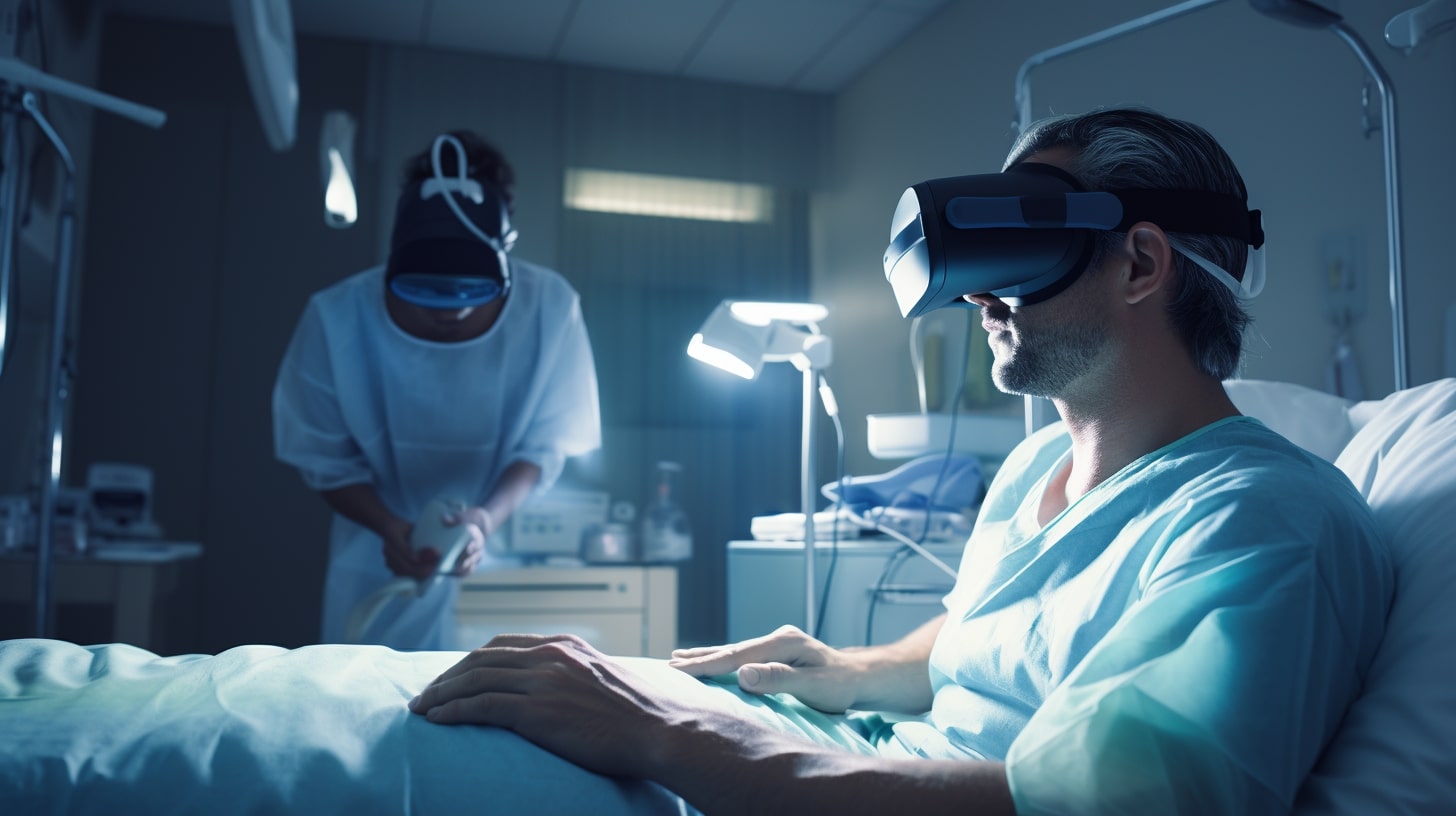Virtual reality technology has revolutionized various sectors. Within healthcare, VR has proven transformative as it redefines patient care, medical education, and surgical precision. At Twin Reality – one of the premier virtual reality companies – we explore how VR is revolutionizing healthcare through immersive experiences that transcend traditional medical practices.
Market Overview

The growth trajectory of the global healthcare VR market as reported by Grand View Research. It shows a significant increase from $3.01 billion in 2022 to an anticipated $29.38 billion by 2030, highlighting the rapidly expanding role of VR technology in the healthcare industry.
This steady climb demonstrates healthcare’s eager embrace of virtual reality technology; due to growing demands for quality care while simultaneously striving to lower costs. Virtual reality (VR) technology now plays a pivotal role in medical practices around the globe as its benefits integrate effortlessly with various medical applications
Key Players and Innovations
Companies such as Surgical Theater, EchoPixel and Medivis are leading this VR revolution. Surgical Theater’s innovative “surgical rehearsal platform” gives neurosurgeons access to virtual reality environments for preoperative planning of complex procedures – improving precision and safety while increasing precision and safety overall.
EchoPixel extends this concept further with True3D; their groundbreaking AR healthcare platform, providing interactive visualization of patient organs and tissues.
Medivis’ combination of medical AR with AI allows it to bring advanced anatomical representations forward – pushing presurgical planning as well as education on anatomical details never before seen before!
Touch Surgery and ImmersiveTouch represent an enormous leap from traditional methods, providing unparalleled depth of understanding and interaction with complex medical data.
Their VR surgical simulations enable medical professionals to practice intricate procedures risk-free within virtual settings – this not only aids skill development, but can significantly decrease learning curves for young surgeons as well.

Diverse Applications in Healthcare
VR’s applications in healthcare extend far beyond operating rooms. Companies like Floreo have leveraged virtual reality for cognitive and social skill development among those living with Autism Spectrum Disorder; providing users with a safe platform where real world situations can be practiced safely – further augmenting traditional therapy methods.
VR technologies developed by InMotion offer engaging and effective physical therapy and rehabilitation solutions, like their Corpus VR platform which gamifies rehabilitation exercises to make them more engaging for patients while giving therapists valuable motion data. This approach not only speeds recovery but keeps patients motivated throughout their rehabilitation journey.
Impact on Healthcare Professionals and Patients
VR in healthcare has proven beneficial for both professionals and patients. VR provides medical staff with a more immersive training environment through immersive programs for medical training; hands-on approaches to learning make these training programs highly effective in enhancing education quality and thus improve medical training outcomes significantly.
Patients using virtual reality will gain new perspectives into understanding and engaging with their health through VR platforms like Floreo. VR cognitive training helps patients overcome challenges associated with autism or cognitive impairments such as dyslexia.
VR’s use in pain management provides a non-pharmacological alternative, thus decreasing medication dependence with its side effects.
Virtual reality in healthcare marks an exciting new era of medical treatment and education; however, its introduction is not without challenges.
A significant one is cost; making VR less accessible for smaller healthcare facilities in emerging markets due to expensive hardware/software requirements; additionally there may be barriers related to widespread adoption as a result of sophisticated hardware/software requirements; plus medical professionals may face difficulties learning to incorporate VR effectively into their practices.
Though VR in healthcare presents challenges, its future looks bright. We anticipate an increasing focus on more user-friendly VR solutions at more reasonable cost that are accessible to a broader range of providers.
Advancements in hardware such as wireless headsets with intuitive controls should enhance user experience further by making VR applications more realistic and immersive.
Expanding Telemedicine Capabilities
VR’s integration into telemedicine is an exciting development. As remote healthcare becomes ever more necessary, virtual reality (VR) offers interactive and personalized consultation experiences, simulating doctor’s visits for easier diagnosis and treatment of patients remotely. The potential applications are vast – particularly providing healthcare to remote or underserved areas.
Enhancing Medical Training and Education (T/E)
VR’s role in medical training and education cannot be overemphasized. By simulating realistic medical environments, it provides medical students and professionals with a safe yet controlled space in which to practice and hone their skills safely and responsibly.
VR in education has revolutionized how students learn anatomy and surgical procedures while making learning interactive and effective; additionally soft skill training applications like VR soft skill training have become essential tools in developing communication and empathy in healthcare professionals.
Industry Applications with Broader Scope
VR technology’s applications go well beyond healthcare; industries including manufacturing, engineering and aviation have begun embracing it for training and simulation purposes. Aviation utilizes VR to train pilots through flight simulation, dramatically decreasing risks and costs associated with real life training sessions; similarly VR in automotive design is revolutionizing design processes.
VR and the Future of Surgery
One of the most exciting applications of VR in healthcare is surgery. VR technology enables surgeons to plan and rehearse complex surgical procedures virtually, thus decreasing errors and improving patient outcomes. For instance, companies like Surgical Theater are leading this revolution with VR solutions that transform MRI scans and CT scans into interactive 3D models for planning surgical procedures in real life.
VR as an Engaging tool in patient education and engagement
VR can play an invaluable role in patient education and engagement. By offering immersive and interactive visualizations of medical conditions and treatments, VR provides patients with better insights into their own health issues and treatment plans, leading to improved compliance and outcomes for treatment plans and plans across sectors. VR for Business illustrates this potential.
Conclusion
Virtual Reality in healthcare represents more than simply technological progress; it represents an innovation which represents a paradigm shift in medical treatment, education and patient care. As VR continues its rapid advancements within health services it will offer more effective, efficient and humanized medical solutions – not simply through adopting new tech; Twin Reality stands ready at the forefront of this revolution, exploring VR’s endless potential within medicine as well as beyond it.

